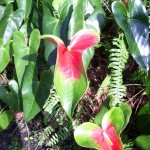Anthurium Andraeanum a.k.a. Andreanum
Anthurium Andraeanum is an extremely popular species of flowering plant from the Araceae family. There are between 800 and 1000 known species of anthurium, but Andraeanum which is also commonly spelled Andreanum is by far the most popular and most commonly grown species. Various Andraeanum cultivars form the core of the anthurium flower industry, which started back in the late 1940s in Hawaii.
Anthurium Facts
Family: Araceae
Genus: Anthurium
Species: Andraeanum
Plant Type: Herbaceous perennial
Zone: 11 to 12
Height: 1 to 1.5 feet
Spread: 0.75 to 1 foot
Bloom Time: Flowers freely
Sun: Part shade
Water: Medium
Maintenance: Medium
Uses: House plant, cut flower
Common Names
Anthurium, tail flower, flamingo flower, cresto de gallo, cockscomb, anturio and boy flower. But anthurium is the common name that is used most widely.
Common Misspellings
Antherium, anturium, arunthium, anthorium, anthiriums, antariam, antorlium, anthuriam, anthrurium, anthirium, anterium and antorium.
Noteworthy Attributes
These plants are native to Central and South America, however many of the original cultivars were initially developed in Hawaii. They produce 6 to 12 heart-shaped flowers a year in a wide assortment of colors. Plants grow to an average of three feet tall, though they can grow much taller in the proper environment. They produce heart shaped leaves that can range from 8 to 18 inches long. It flowers year round in tropical conditions and seeds are unlikely to be produced on indoor plants without manual pollination procedures.
Anthurium Care Guidelines
Outside of the tropics, it can be grown in most parts of the world as a potted houseplant. Proper anthurium care starts with using a very well-drained potting mixture. And remember to put a layer of pot shards, marbles or gravel at the bottom of the pot to further ensure good drainage. Bright light is required, but direct sunlight can burn these plants. They require consistent watering throughout the year and they do not go dormant during the winter. Ensure that they are not exposed to temperatures less than 60 degrees for any extended period. They require high humidity or frequent misting with water. Repot every two years and utilize a thin layer of sphagnum or peat moss on the surface to retain a little moisture.
Caution Poisonous
Anthuriums can be poisonous to humans and pets. They contain Calcium oxalate which can cause oral irritation and difficulty swallowing, so keep them out of reach of children and pets.
Solutions To Common Anthurium Problems
Dark Spots On Leaves
If you keep your plant in a cold location and the leaves of your plant develop dark spots, you should try moving it to a warmer area.
Leaves Are Turning Yellow And Withering
This can be caused by excessive exposure to sunlight. If your plant is in a very sunny spot, try moving it to a location that receives less sunlight.
Scale Insect Infestation
If your plant is attacked by scale insects, mix a mild solution of soap and water and use a soft cloth to wipe down the leaves of your plant.
Stunted Growth And Small Shriveled Leaves
This may be caused by a fungal infection that is affecting the roots of your Anthurium Andraeanum. Prevent this from occurring by using a well drained potting soil and being careful with your watering. If this has already occurred, try repotting into a well drained soil and trimming away diseased portions of the plant.

